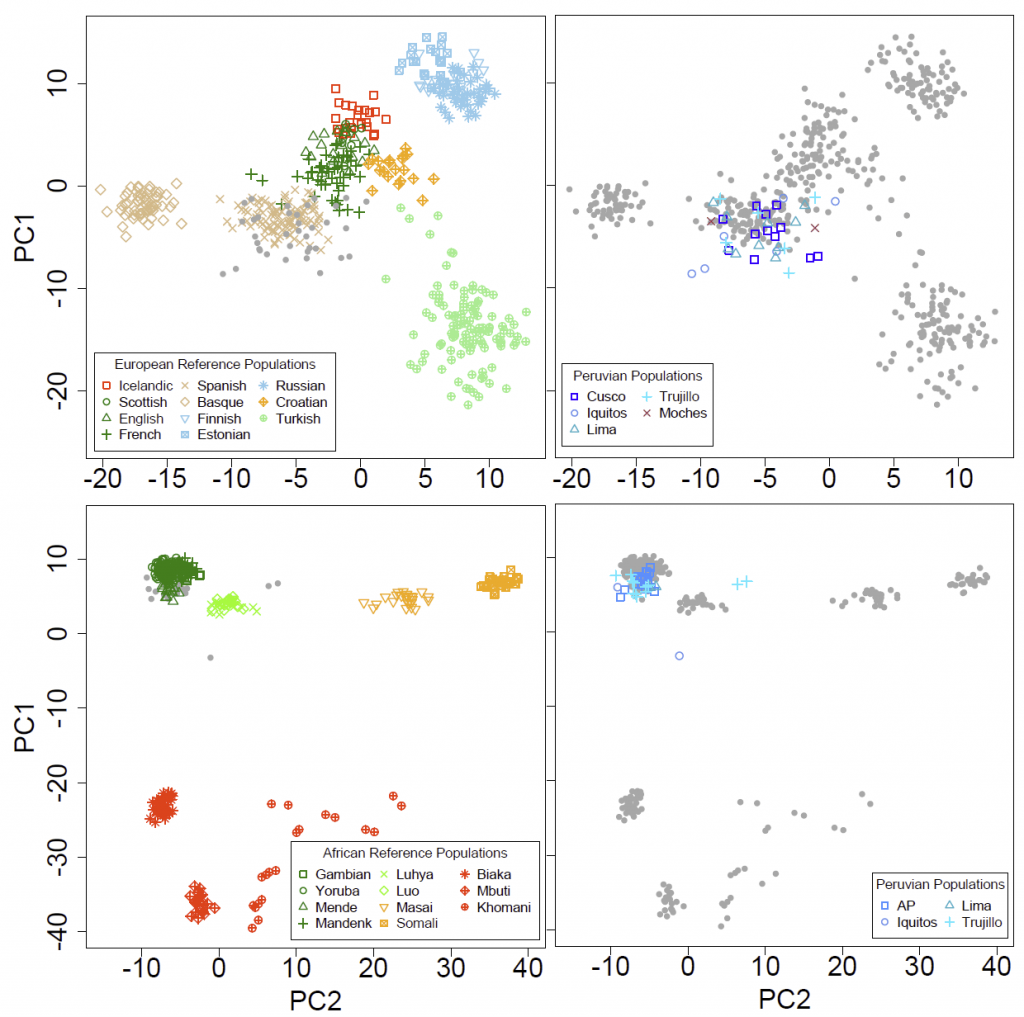Open access Evolutionary genomic dynamics of Peruvians before, during, and after the Inca Empire by Harris et al., PNAS (2018) 201720798 (published ahead of print).
Abstract (emphasis mine):
Native Americans from the Amazon, Andes, and coastal geographic regions of South America have a rich cultural heritage but are genetically understudied, therefore leading to gaps in our knowledge of their genomic architecture and demographic history. In this study, we sequence 150 genomes to high coverage combined with an additional 130 genotype array samples from Native American and mestizo populations in Peru. The majority of our samples possess greater than 90% Native American ancestry, which makes this the most extensive Native American sequencing project to date. Demographic modeling reveals that the peopling of Peru began ∼12,000 y ago, consistent with the hypothesis of the rapid peopling of the Americas and Peruvian archeological data. We find that the Native American populations possess distinct ancestral divisions, whereas the mestizo groups were admixtures of multiple Native American communities that occurred before and during the Inca Empire and Spanish rule. In addition, the mestizo communities also show Spanish introgression largely following Peruvian Independence, nearly 300 y after Spain conquered Peru. Further, we estimate migration events between Peruvian populations from all three geographic regions with the majority of between-region migration moving from the high Andes to the low-altitude Amazon and coast. As such, we present a detailed model of the evolutionary dynamics which impacted the genomes of modern-day Peruvians and a Native American ancestry dataset that will serve as a beneficial resource to addressing the underrepresentation of Native American ancestry in sequencing studies.

Interesting excerpts
The high frequency of Native American mitochondrial haplotypes suggests that European males were the primary source of European admixture with Native Americans, as previously found (23, 24, 41, 42). The only Peruvian populations that have a proportion of the Central American component are in the Amazon (Fig. 2A). This is supported by Homburger et al. (4), who also found Central American admixture in other Amazonian populations and could represent ancient shared ancestry or a recent migration between Central America and the Amazon.
Following the peopling of Peru, we find a complex history of admixture between Native American populations from multiple geographic regions (Figs. 2B and 3 A and C). This likely began before the Inca Empire due to Native American and mestizo groups sharing IBD segments that correspond to the time before the Inca Empire. However, the Inca Empire likely influenced this pattern due to their policy of forced migrations, known as “mitma” (mitmay in Quechua) (28, 31, 37), which moved large numbers of individuals to incorporate them into the Inca Empire. We can clearly see the influence of the Inca through IBD sharing where the center of dominance in Peru is in the Andes during the Inca Empire (Fig. 3C).

A similar policy of large-scale consolidation of multiple Native American populations was continued during Spanish rule through their program of reducciones, or reductions (31, 32), which is consistent with the hypothesis that the Inca and Spanish had a profound impact on Peruvian demography (25). The result of these movements of people created early New World cosmopolitan communities with genetic diversity from the Andes, Amazon, and coast regions as is evidenced by mestizo populations’ ancestry proportions (Fig. 3A). Following Peruvian independence, these cosmopolitan populations were those same ones that predominantly admixed with the Spanish (Fig. 3B). Therefore, this supports our model that the Inca Empire and Spanish colonial rule created these diverse populations as a result of admixture between multiple Native American ancestries, which would then go on to become the modern mestizo populations by admixing with the Spanish after Peruvian independence.
Further, it is interesting that this admixture began before the urbanization of Peru (26) because others suspected the urbanization process would greatly impact the ancestry patterns in these urban centers (25). (…)
Related
- Native American genetic continuity and oldest mtDNA hg A2ah in the Andean region
- Male-biased expansions and migrations also observed in Northwestern Amazonia
- Ancient human parallel lineages within North America contributed to a coastal expansion
- Population structure in Argentina shows most European sources of South European origin
- Latin Americans show widespread Mediterranean and North African ancestry
- Patterns of genetic differentiation and the footprints of historical migrations in the Iberian Peninsula
- Ancient Patagonian genomes suggest origin and diversification of late maritime hunter-gatherers
- Ancient DNA reveals temporal population structure of pre-Incan and Incan periods in South‐Central Andes area
- Paternal lineages mainly from migrants, maternal lineages mainly from local populations in Argentina